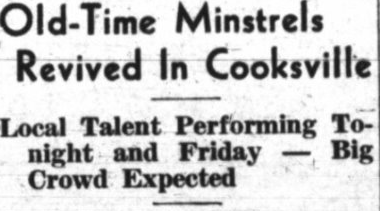The History of Mississauga’s Minstrel Past
/Image featured on the front page of Port Credit Weekly, 1948
Blackface minstrelsy originated in the 1830s in the Northern United States. By applying burnt cork makeup, white actors depicted parodies of enslaved Black people. Obscuring the realities of black life, blackface minstrelsy is centred around stereotypes that equate black identity with laziness, ignorance, childishness and hypersexuality. Playing into the façade of Canadian race relations being far superior to the United States, many today may dismiss the fact that blackface occurred outside of the Southern States, let alone in historic Mississauga. It may also come as a surprise that large scale blackface performances continued in Mississauga until the early 1970s. Only a single generation has passed since blackface was performed in Mississauga’s public spaces that remain in operation.
Today, schools and community centres are arguably two of the most fundamental municipally owned buildings which strive to be inclusive spaces for all. Research into Mississauga’s archival newspaper articles showed blackface minstrel shows were presented at Streetsville Secondary School, Dixie Public School, and Clarkson Community Centre, to name a few. Some groups put on shows as a one-time performance, like what was reported to have occurred at a 1944 minstrel show at Cooksville Town Hall and Dixie Public School who broadcasted to radio. However, the Clarkson Minstrel’s Blackface Jamboree and the Streetsville Lions Club’s Minstrels Memories, were annual events. These performances were complete with media anticipation, large crowds (400 tickets would sell out for multiple night showings), and full casts (average of 50 performers). Inky, Ebony and Sambo, were among the stage names of those who were praised for their “showcase of talent,” which “district residents would have to go a long way to find a better show of this type.” Song and production titles such as Snow White and the Seven Spasms, Shine and Ol’ Man River show that entertainment in our city has not always respectfully celebrated cultural diversity. Rather the opposite, it seems.
Headline from Port Credit Weekly article, 1944
While the time frame for blackface minstrelsy is most often associated with slavery and the reconstruction era, Streetsville’s first Minstrel Memories show took place in 1944. This show was described as a “strong comeback.” An article published by the Port Credit Weekly wrote of Frank Taylor, former interlocutor (leader) of the Clarkson Minstrels between 1910-1912, being pleased to view a modern revival with very little difference between the shows he led in the past. Associating blackface with nostalgia was a tactic used to override the harmfulness of this practice. Initiatives such as welcoming senior citizens into shows free of charge, and having the Clarkson Minstrels perform for men at Sunnybrook Hospital are examples of blackface in Mississauga being upheld as nothing more than “old reliable community entertainment.” In a sarcastic warning, meant to lure readers into attending the Blackface Jamboree, the words “don’t go if your denture is loose or you fail to find pleasure in soul-stirring singing” were used. After all, anyone who didn’t appreciate the minstrelsy form of “humour” were not the intended audience- their opinions could be easily dismissed.
Advertisment featured in Port Credit Weekly, 1952
The theme of charity was also used to uphold the practice. When the Clarkson Minstrels worked to revive themselves in the early 1940s, the Lion Club’s philanthropic values were used to support the excitement for bringing back the practice after “the minstrel show [had] sadly been neglected as a means of raising funds for community work.” Some of the charitable causes that Mississauga’s minstrel shows supported were the Victorian Order of Nurses, the Children’s Welfare Fund and The Ontario Farm Home for the Deaf. With tickets being sold at the Port Credit Weekly’s office and the shows being sponsored by local businesses and churches, blackface was not something that was privately practiced by a few, but a significant aspect of Mississauga’s cultural history.
Political events in the United States had some effect but failed ultimately to stop the shows. One month after the assassination of Dr. Martin Luther King Jr. in 1968, the Streetsville Lions Club admitted “Minstrel Memories [had] come under attack in the past from ultra-civil rightists and others simply concerned about the potential damage a blackface show might do to racial relations in these touchy times.” However, they defended the practice as, “[nothing] more than a gentle spoof and hardly, in these times and this country, bearing overtones of racism.” The group opted to use that year’s blackface show as a chance to stage a “tasteful and eloquent tribute.” This mainly involved singing the same hymn that was sung at Dr. King’s funeral. Despite this, Minstrel Memories continued for seven more years until roughly 1973.
'Old-Minstrels Revived in Cooksville' The Port Credit Weekly, 1944.
One would expect to find such racialized entertainment like Minstrel Memories and Blackface Jamboree to be events that happened far from our city. It must have been something that happened so long ago that living memories no longer exist, right? Rather, these shows only ended a year before our city was amalgamated and formed in 1974. Coincidentally, this was the same time in Mississauga’s history when immigration from diverse countries began in earnest. Canada is not immune to these sins, and neither are we. By uncovering these historical connections, we can think honestly about where we are starting from and where we want to go.














